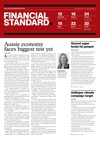Search Results | Showing 1 - 10 of 45 results for "carbon risk" |
| | | ... interim goal of 20% by 2025. Additionally, 69% of its direct real estate assets under management are aligned with the Carbon Risk Real Estate Monitor (CRREM) for the second year running. In listed assets, AXA IM reduced the carbon intensity of its corporate ... |
| | | | ... change and sustainability partner Emma Herd, "investors are grappling with how to balance the different facets of carbon risk across their portfolio. "The report provides a useful exploration of the delicate balance that investors need to maintain to ... |
| | | | ... peripheral markets, targeting office buildings. The aim is to maintain the carbon footprint of the portfolio below the carbon Risk Real Estate Monitor's 1.5°C trajectory model at all times and to target a reduction of -40% GHC emissions by 2030. Conducting ... |
| | | | ... across. The second metric is an assets under management target for 50% of the real estate portfolio to be aligned to the Carbon Risk Real Estate Monitor (CRREM) trajectories by 2025. For the ESG part of the deferred compensation, this metric accounts ... |
| | | | ... path and reduction in carbon," Squires said. "Robeco we saw as a leader in the marketplace in general integration of carbon risk and ESG risk. As a firm, they're really aligned with what we're trying to do and with the mandate, it allows ups ... |
| | | | ... Scope 3 emissions, which include indirect value chain and use of sold products, are responsible for 71% of the total carbon risk of the ASX 300 and remain largely undisclosed by companies. Emmi's estimates are generated by its data engine which houses ... |
| | | | Fintech and carbon risk solution company Emmi has launched Carbon Intelligence, a platform designed to assist investors in analysing carbon transition risk and opportunity in a portfolio. Carbon Intelligence applies Emmi's proprietary Global Carbon ... |
| | | | ... Cbus Super's goal was to seek the removal of carbon emissions in underlying assets, rather than just removing carbon risk to portfolio by divesting from the heaviest emitters. |
| | | | ... intensity, what you're doing is not necessarily quantifying the risk, you're categorising it," Hurst said. "The way I see carbon risk is like a spectrum - low risk rising to high risk, and the question should be, what risk am I prepared to tolerate? ... |
| | | | ... are more backward looking or based on carbon intensity measurements, versus, say, forward looking measurements of carbon risk, whether that be looking at corporate strategy from a company by company level, or an asset class by asset class level." When ... |
|

















